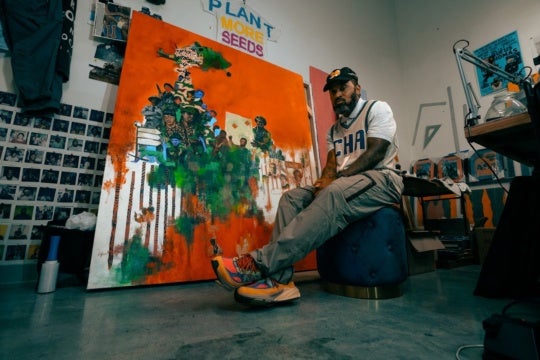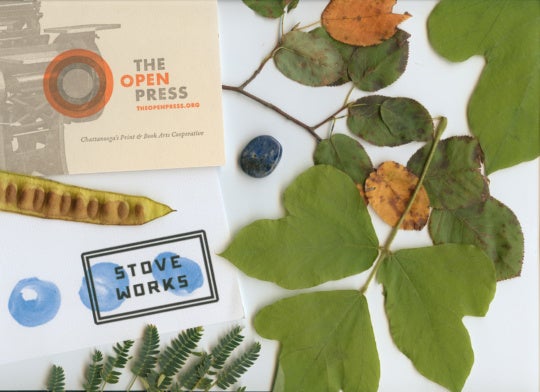
In his latest installation, Pyrrhic Victory, the Atlanta- and Savannah-based artist Trevor Reese manages to transform Whitespec, the broom-closet experimental art space at Whitespace gallery, into a tonally saturated cloister that forces viewers to confront their inalienable physicality. The work consists of four elements: a sledgehammer, an audio track, a demolished piano, and a video playing in reverse on a flat-screen monitor. The video opens in front of an anonymous apartment building, the much abused instrument lying on its belly with a 5-pound sledge resting on its carcass. Then the action begins as the hammer flies off-screen, the piano stands up, and the artist begins reconstructing it one hammer-strike at a time. In reality, Reese demolished the piano with his sledgehammer; in the world of the video, he builds it out of dust and splinters.
The minor key throb of the real-time audio of Reese’s reverse strikes resonates with the sledgehammer leaning in the corner like a museum display of jobsite anthropology. It’s too minimalist, too cavalier and understated. It starts the viewer considering not meaning or ontology but offers a sort of somatic entreaty to consider your physical self and the space you occupy. This is a work that hits you in the body. From the rough-hewn reconstructed piano in the room to the clouds of dust in the video that gently serry in the air and then rush into the piano in acts of violent, serial ensoulment as the hammer pulls away. It’s enlivening, it’s breathing life, vipassana-style.

There is nothing necessarily performative or composed about Reese’s movements in the video. He rejects a workmanlike studiousness or hammer-blow brio in favor of recalcitrant amateurism. Our character in this work is not a destructive virtuoso — you feel like you can see it in his thwacks, even in reverse, a diffidence against his own act of destruction. In this and in other ways, he is reminiscent of Macon Blaire’s underwrought everyman, Dwight, in the hauntingly bathetic film Blue Ruin (2013). Blaire nails the role of a vagabond set on a path of inept, bungling revenge when his parents’ murderer is released from prison. The film ends with six corpses, Reese’s piece begins with one. Both works, Blue Ruin and Reese’s installation, depict and constitute, respectively, pyrrhic victories—ones in which the achievement comes with greater sacrifice than they are worth. For Dwight, it’s that he gets his vengeance and then some but dies in the attempt. Meanwhile, for Reese, the pyrrhic victory is the figure of the piano itself. In its reconstitution, it is yet sundered; standing, it remains broken. Conversely, beyond the exertions and the depredations, the piano has been reassembled, after all, rendering otiose all that vicious pounding in the first place.
More significantly, both works wrap the viewer in the physical truth of having a body. There is a scene in Blue Ruin where Dwight attempts surgery on himself after being shot with a crossbow bolt, and rather than playing out in machismo grit and action-hero resolve, we see him cringe and whimper as spittle drips from his wincing mouth. The scene puts you in your own body and it hurts a little. Reese’s does that too by the squirrely reluctance of his movements, and by placing you in the room with the piano itself. It takes up a lot of real estate, and unless you have the room to yourself, it means you’re watching the video on the piano’s terms. It’s not crowded, but it feels crowded, and what do crowds do but remind you of the dimensions of your corporeality?

Does all this seem too referential, evocative, or tenuous? Perhaps, but that is the nature of Reese’s work—to elicit these rogue associations. Why else freight the viewer with obscure pulls like zugzwang—referring to a state of affairs in a board game in which a player is forced to move into a disadvantaged position— which the artist professes, in the nearby artist statement, is an inalienable part of the work?
Is Pyrrhic Victory a successful work of art? Yes, because it directly transmutes the viewer’s attention into a sense of ambiguous profundity in a way that doesn’t bludgeon as a lot of video art can do. That profundity has something to do with movement, bodily and more abstractly—as in having to make a move. To act. To do, especially when one would eagerly rather not. To be here in a body, without recourse to mulligan or annulment, committed to a forced error. What does a reconstituted thrift-shop piano have to say about all this but a rewound realization that it’s a strange game; that the only winning move is not to play?
Nicholas Adams is an artist based in Atlanta. He received his MFA from Georgia State University in 2015, a year before Trevor Reese received his MFA in the same program.




